|
Alarm Group Maintenance This Help File Page was last Modified on 12/10/2013 |

|

|
|
|
Alarm Group Maintenance This Help File Page was last Modified on 12/10/2013 |

|

|
Alarm Group Maintenance
This Help File Page was last Modified on 12/10/2013
|
Alarm Group Maintenance This Help File Page was last Modified on 12/10/2013 |

|

|
|
|
Alarm Group Maintenance This Help File Page was last Modified on 12/10/2013 |

|

|
| □ | Each Subscriber's Alarm System that will be monitored with this Central Station Monitoring module, must be identified as a monitored account in the Central Station Data Form. |
| • | As part of that process, each monitored Subscriber must be assigned to an Alarm Processing Group code within the Central Station Data Form, thus defining the Alarm Processing Group to which this monitored account is to be a member. |
| • | Examples of an Alarm Processing Group are Spanish Speaking, English Speaking, High Value Account, UL® Commercial, and Supervised for Open/Close. You may define as many Alarm Processing Groups as appropriate for your business model. |
| • | Assigning an Alarm Processing Group classification assures that the Subscriber's signals are routed to Operators that will better understand the type of system being monitored, or speaks the language the person to which (s)he is currently responding will also be speaking. |
| • | Any Subscriber that does not need to be specifically assigned to a special Alarm Processing Group should at least be assigned to the Default group. |
| • | Signals received from the Default Group may be processed by any available Operator. |
| • | The Alarm Processing Group also provides a Special Filter code for the Subscriber Listing and a selection capability for many other Central Station Reports. |
| • | You must also assign one or more of the Alarm Processing Groups to each Employee (Operator) that may be required to monitor signals from that Alarm Processing Group within the Employee Form's Alarm Groups tab. |
| • | At a minimum, the Operator must be assigned to the Default group. |
| • | There is no limit to the number of Alarm Processing Groups to which an Employee (Operator) may be assigned. |
| • | From time to time you may need to transfer specific Subscribers into, or out of, one of these Alarm Processing Groups. |
| • | You will use this Alarm Group Maintenance Form to make these transfers. |
| □ | Alarm Group Maintenance procedures: |
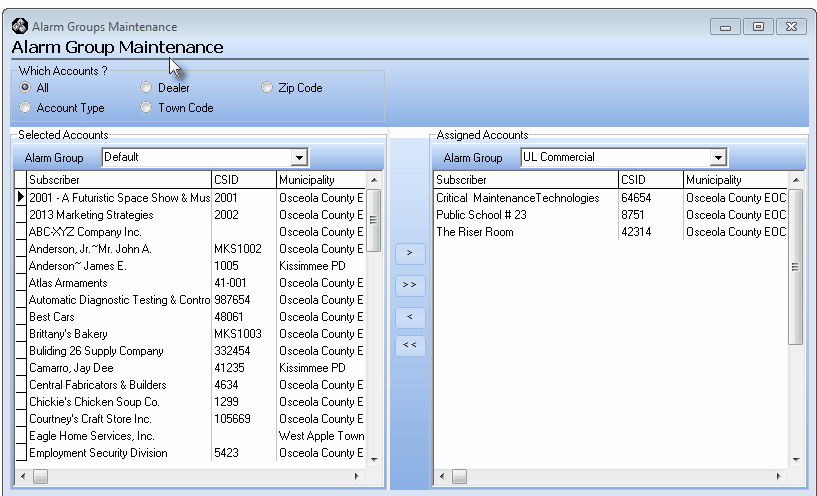 mERCER
mERCER
Alarm Group Maintenance dialog
| • | To perform Alarm Group Maintenance, on the Main Menu Select Maintenance and Choose Central Station then Click Alarm Group Maintenance. |
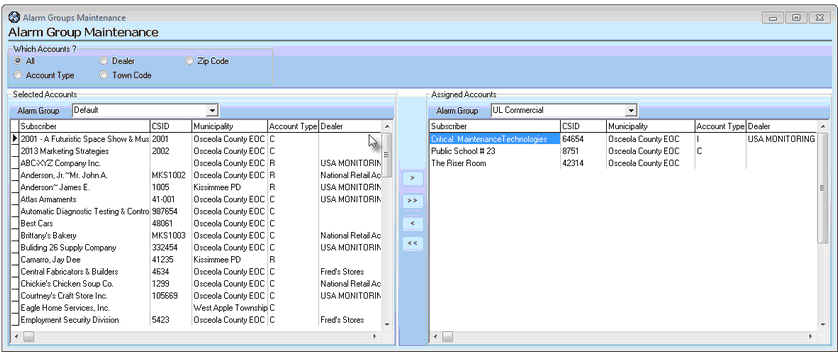
Expanded view of the Alarm Group Maintenance form with all data columns showing
| • | Which Accounts? - Choose which Accounts will be displayed in the Selected Accounts section. |
| • | All - The default - makes all Accounts available for selection. |

Which Accounts? buttons - Select Which Accounts field
| • | Any other choice will display the "Select Which Accounts" field (on the right) with an Ellipse (see the mouse pointer in the illustration above) that is used to access the appropriate Search dialog (or Zip Code entry field), based on the Which Accounts? choice made below: |
| ▪ | Account Type - Limit the Accounts available for selection within the Selected Accounts section to those assigned the Account Type chosen in the Search Account Types dialog. |
| o | Choose the Search By field using the Drop-Down Selection List provided |
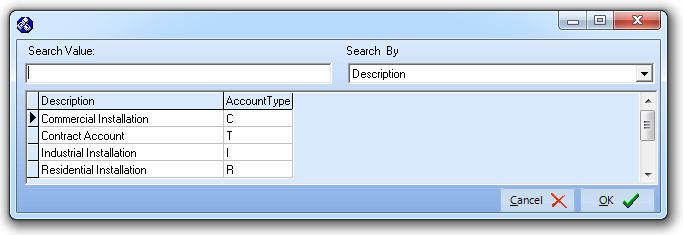
Search Account Types dialog
| o | Enter the appropriate Search Value to located the desired record. |
| o | When the Record Pointer „ is directed at the required record, Click the OK ü button. |
| o | The Name of the Account Type that was selected will be inserted into the Select Which Accounts field (as shown below). |

| ▪ | Dealer - Limit the Accounts available for selection within the Selected Accounts section to those assigned the Dealer Code chosen in the Search Dealers dialog. |
| o | Choose the Search By field using the Drop-Down Selection List provided |
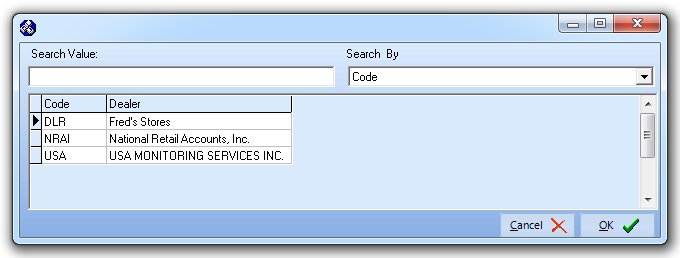
Search Dealers dialog
| o | Enter the appropriate Search Value to located the desired record. |
| o | When the Record Pointer „ is directed at the required record, Click the OK ü button. |
| o | The Name of the Dealer Code that was selected will be inserted into the Select Which Accounts field (as shown below). |

| ▪ | Town Code - Limit the Accounts available for selection within the Selected Accounts section to those assigned the Town Code chosen in the Search Town Codes dialog. |
| o | Choose the Search By field using the Drop-Down Selection List provided |
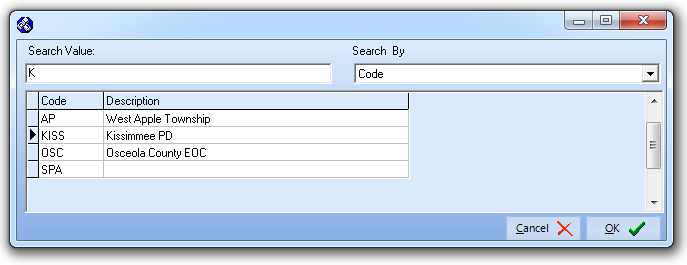
Search Town Codes dialog
| o | Enter the appropriate Search Value to located the desired record. |
| o | When the Record Pointer „ is directed at the required record, Click the OK ü button. |
| o | The Name of the Town Code that was selected will be inserted into the Select Which Accounts field (as shown below). |

| ▪ | Zip Code - Limit the Accounts available for selection within the Selected Accounts area to the one entered in the Zip Code entry box in the Select Which Accounts. |
| o | You must Click the Execute button after entering the desired Zip Code. |

Zip Code entry with Execute button
| • | Selected Accounts - Once the "Which Accounts?" option is selected the list of Selected Accounts section will be updated based on two factors: |
| 1. | The Which Accounts? selection determines the "pool" of Accounts that may be displayed in the Selected Accounts section |
| 2. | The Alarm Group choice determines which of the Accounts in that "pool" will actually be displayed in the Selected Accounts section |
![[PICTURE HelpFilesAlarmGroupMaintenanceSelectedAccountsAlarmGroup.bmp]](%5Bpicture%20helpfilesalarmgroupmaintenanceselectedaccountsalarmgroup.bmp%5D.png)
| ▪ | Alarm Group - Select an Alarm Group to filter the available "pool" of Account - based on the Alarm Group that was previously assigned to each of those Accounts - by using the Drop-Down Selection List provided. |
| ▪ | Once the Alarm Group is chosen, the list of Selected Accounts will be updated (filtered) to reflect both the "Which Accounts?" selection, and the Alarm Group selection. |
| • | Assigned Accounts - Using the Drop-Down Selection List provided, Select the Alarm Processing Group to which the (specifically selected sub-set of) Selected Accounts will now be assigned. |

Assigned Accounts Alarm Group dialog
| • | Move - Now that the appropriate set of Selected Accounts is being displayed, Choose which of those Accounts are to be reassigned to the Alarm Group chosen in the Assigned Accounts section: |
| • | Within the Selected Accounts list, Control+Click on each of the Account(s) to be assigned to a another Alarm Group. |
| ▪ | After selecting the Accounts to be moved, be sure to Choose the appropriate Alarm Group to which these Account(s) should be assigned (see Assigned Accounts above). |
| • | Then Move Account(s) by Clicking either the single right arrow (> for moving only the selected Accounts), or the double right arrow (>> to move all Accounts within the Selected Accounts list) to the Assigned Accounts section. |
| ▪ | This Move action will automatically update the Alarm Group entry in the Subscriber's Central Station Data Form. |
| ► | Note: This process may also be performed in reverse if you need to move Assigned Accounts back to the Selected Accounts section. |
| i. | Select the appropriate Account(s) |
| ii. | Click the left pointing arrow(s) to return them to the left side of the form. |